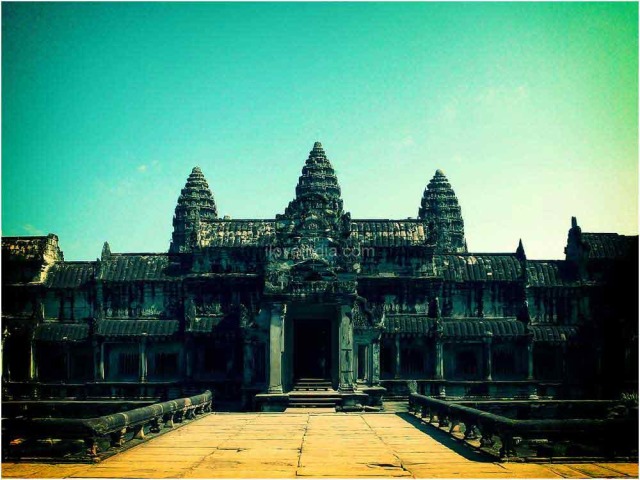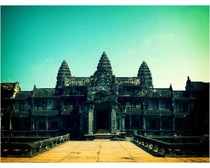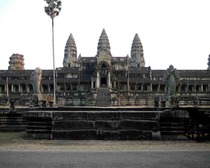Angkor Wat is a temple situated in Angkor, Cambodia, founded by Suryavarman II. With this article, you will get to know many fun and interesting facts about Angkor Wat.
Facts About Angkor Wat
Angkor Wat is a temple that forms a part of the Angkor city of Cambodia. It was built as the state temple of King Suryavarman II, in his capital city Angkor. The central temple complex of Angkor Wat is a bas-relief, approximately 800 meters in length. The relief depicts the Battle of Kurukshetra, the Army of Suryavarman II, Heaven and Hell, Churning of the Ocean of Milk, Elephant Gate, Vishnu Conquers the Demons, Krishna and the Demon King, Battle of the Gods and the Demons and the Battle of Lanka. Built as per classical style of Khmer architecture, the temple is a beauty in itself and forms a major attraction of Cambodia. However, the temple was never finished because of the king’s death before its accomplishment. Various incomplete decorations prove this fact. Yet this temple reveals architectural wonders which took place during the Khmer civilization. Also, it is the biggest single Hindu temple complex and religious monument in the world. Just go through the lines below and get to know some more fun and interesting facts about Angkor Wat.

Fast Facts
Location: Angkor, Cambodia
Built in: 12th Century
Built by: Suryavarman II
Historical Importance: The largest single religious structure in the world.
Fun & Interesting Facts About Angkor Wat
- Angkor Wat is a temple situated in Angkor, Cambodia.
- Angkor was built in the early 12th century, for King Suryavarman II, as his state temple and capital city.
- Angkor Wat is built as per high classical style of Khmer architecture.
- Angkor Wat can be seen on the national flag of Cambodia, since the introduction of the first version.
- Angkor Wat has been designed in such a way that it represents Mount Meru, abode of Lord Brahma and the Demi Gods (Devtas) according to the Gods in Hindu mythology.
- Angkor Wat is oriented to the west, unlike most of the other Angkorian temples that face east.
- Angkor Wat came to be known by its present name since the 16th century. Prior to that, it was known as Pisnulok, after the posthumous title of its founder, Suryavarman II.
- A quincunx of towers, symbolizing the five peaks of Mount Meru, stands at the center of Angko Wat.
- Initially, Angko Wat was constructed as a temple dedicated to Lord Vishnu. It was in the 14th or 15th century that it was converted to Theravada Buddhist temple.
- Antonio da Magdalena, a Portuguese monk, was one of the first Western visitors to Angko Wat, in 1586.
- Angkor Wat stands on a terrace that has been raised higher than the city.
- Angkor is spread over an area of approximately 400 sq. km, including the surrounding forest.
- Angkor was declared as a World Heritage Site by UNESCO, in 1992.
- Apart from Angkor Wat, Angkor city comprises of Angkor Thom and the Bayon Temple.
- Angkor Wat is believed to be the biggest pyramid in the entire Asian continent.
- Angkor Wat is 65m high and stands divided into several layers.
- Angkor Wat is the largest and most beautiful temple in the entire complex of Angkor.
- Though all the temples are built with an orientation towards the east, Angkor Wat is an exception; it is aligned towards the west.
- Although Suryavarman II belonged to lineage of kings who practiced ‘Shaivism’ (revering God Shiva as the Supreme Lord), yet he broke the tradition to dedicate this temple to lord Vishnu.
- The decorations of the temple are known for their storytelling characteristics, which portray stories or fables from the Hindu epics.
- The temple was converted to Mahayana Buddhism during the reign of Jayavarman VII, the greatest of all Angkorian kings. After his death, there was a brief revival of Hinduism and some statues of Buddha were demolished, until the Theravada Buddhism conquered Angkor.
- The site receives more than 2 million visitors annually.


See also
More from iloveindia.com
- Home Remedies | Ayurveda | Vastu | Yoga | Feng Shui | Tattoos | Fitness | Garden | Nutrition | Parenting | Bikes | Cars | Baby Care | Indian Weddings | Festivals | Party ideas | Horoscope 2015 | Pets | Finance | Figures of Speech | Hotels in India : Delhi | Hyderabad | Chennai | Mumbai | Kolkata | Bangalore | Ahmedabad | Jaipur
- Contact Us Careers Disclaimer Privacy Policy Advertise With Us Lifestyle Sitemap Copyright iloveindia.com. All Rights Reserved.







